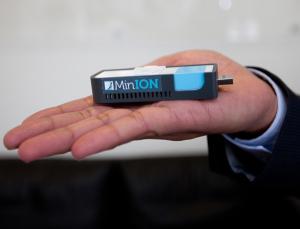Via NewScientist
-----

(Image: Oxford Nanopore Technologies)
It may look like an ordinary USB memory stick, but a
little gadget that can sequence DNA while plugged into your laptop could
have far-reaching effects on medicine and genetic research.
The UK firm Oxford Nanopore built the
device, called MinION, and claims it can sequence simple genomes – like
those of some viruses and bacteria – in a matter of seconds. More
complex genomes would take longer, but MinION could also be useful for
obtaining quick results in sequencing DNA from cells in a biopsy to look
for cancer, for example, or to determine the genetic identity of bone
fragments at an archaeological dig.
The company demonstrated today at the
Advances in Genome Biology and Technology (AGBT) conference in Marco
Island, Florida, that MinION has sequenced a simple virus called Phi X,
which contains 5000 genetic base pairs.
Proof of principle
This is merely a proof of principle –
"Phi X was the first DNA genome to be sequenced ever," says Nick Loman, a
bioinformatician at the Pallen research group at the University of
Birmingham, UK, and author of the blog Pathogens: Genes and Genomes. But
it shows for the first time that this technology works, he says. "If
you can sequence this genome you should be able to sequence larger
genomes."
Oxford Nanopore is also building a
larger device, GridION, for lab use. Both GridION and MinION operate
using the same technology: DNA is added to a solution containing enzymes
that bind to the end of each strand. When a current is applied across
the solution these enzymes and DNA are drawn to hundreds of wells in a
membrane at the bottom of the solution, each just 10 micrometres in
diameter.
Within each well is a modified version
of the protein alpha hemolysin (AHL), which has a hollow tube just 10
nanometres wide at its core. As the DNA is drawn to the pore the enzyme
attaches itself to the AHL and begins to unzip the DNA, threading one
strand of the double helix through the pore. The unique electrical
characteristics of each base disrupt the current flowing through each
pore, enough to determine which of the four bases is passing through it.
Each disruption is read by the device, like a tickertape reader.
Long strands, and simple
This approach has two key advantages
over other sequencing techniques: first, the DNA does not need to be
amplified - a time-consuming process that replicates the DNA in a sample
to make it abundant enough to make a reliable measurement.
Second, the devices can sequence DNA
strands as long as 10,000 bases continuously, whereas most other
techniques require the DNA to be sheared into smaller fragments of at
most a few hundred bases. This means that once they have been read they
have to be painstakingly reassembled by software like pieces of a
jigsaw. "We just read the entire thing in one go," as with Phi X, says
Clive Brown, Oxford Nanopore's chief technology officer.
But Oxford Nanopore will face stiff
competition. Jonathan Rothberg, a scientist and entrepreneur who founded
rival firm 454 Life Sciences, also announced at the AGBT conference
that his start-up company, Ion Torrent, will be launching a desktop
sequencing machine. Dubbed the Ion Proton, it identifies bases by using
transistors to detect hydrogen ions as they are given off during the
polymerisation of DNA.
This device will be capable of
sequencing a human genome in 2 hours for around $1000, Rothberg claims.
Nanopores are an "elegant" technology, he says, but Ion Torrent already
has a foot in the door. "As we saw last summer with the E. coli outbreak in Germany, people are already now using it," he says.
Pocketful of DNA
By contrast, the MinION would take
about 6 hours to complete a human genome, Brown claims, though the
company plans to market the device for use in shorter sequencing tasks
like identifying pathogens, or screening for genetic mutations that can
increase risk of certain diseases. Each unit is expected to cost $900
when it goes on sale later this year.
"The biggest strength of nanopore
sequencing is that it generates very long reads, which has been a
limitation for most other technologies," says Loman. If the costs,
quality, ease of use and throughput can be brought in line with other
instruments, it will be a "killer technology" for sequencing, he says.
As for clinical applications, David
Rasko at the Institute for Genome Sciences at the University of Maryland
in Baltimore, says the MinION could have huge benefits. "It may have
serious implications for public health and it could really change the
way we do medicine," he says. "You can see every physician walking
around the hospital with a pocketful of these things." And it will
likely increase the number of scientists generating sequencing data by
making the technology cheaper and more accessible, he says.


